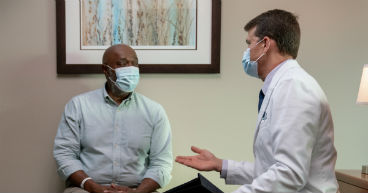
Al Roker has been a TV weatherman for more than four decades, and during those years, he’s kept NBC’s Today Show viewers informed about approaching hurricanes, blizzards and heat waves.
Roker announced recently that he is also now a cancer patient. And although he’s had that distinction for just a few months, his mission is the same: educating and informing his viewers—this time about prostate cancer and screening and treatments for the disease.
“After a routine checkup in September, it turns out I have prostate cancer,”
Roker said while announcing his diagnosis on Nov. 6. “It’s a little more common than people realize. But if you detect it early, it is a really treatable disease, which is why I wanted to take you on my journey, so we can get educated together and learn how to protect the men in our lives.”
Indeed, Roker revealed several aspects of his September diagnosis that may be helpful in educating men about screening, risk factors and other aspects of prostate cancer. Below are four lessons Roker’s case may be able to teach us about the disease.
1. Get a PSA test
Roker’s cancer journey began with a prostate specific antigen (PSA) test during a routine examination. PSA is a protein found in the prostate that helps semen maintain its liquid form.
If a man’s PSA is above a certain level it may indicate the presence of prostate cancer cells. Normal PSA levels change with age.
“PSA is one of the most successful cancer screening tools we’ve ever seen,” says Francis Schanne, MD, Urologist at Cancer Treatment Centers of America® (CTCA), Philadelphia. “But it’s gotten a bad rap.”
The use of PSA tests has drawn criticism because they may sometimes produce false positives, potentially resulting in inaccurate diagnoses. High PSA levels may be caused by a urinary tract infection, benign prostatic hyperplasia or other noncancerous conditions. An over-diagnosis based on a PSA may lead some patients to get expensive and unnecessary diagnostic tests or even treatments.
Dr. Schanne says PSA tests should be considered one of many tools doctors can use to eventually determine whether a patient has prostate cancer.
“Not every elevated PSA level means prostate cancer, so it should be used with caution,” he says. “But I do encourage all men over 50 to get screened.”
In Roker’s case, follow-up exams after his PSA test led to an MRI and a biopsy that confirmed the diagnosis.
2. Consider risk factors
Roker has at least two important risk factors for prostate cancer, which is one reason he went public with his diagnosis:
- He’s 66, which happens to be the average age of men diagnosed with prostate cancer.
- He’s African American, the highest risk factor group for the disease.
Other risk factors include a family history of the disease, and the presence of the BRCA gene, which, in women, may indicate a higher risk for breast and ovarian cancers.
“It’s recommended that most people be screened at the age of 50,” Dr. Schanne says. “But people in higher-risk groups should get screened earlier.”
Prostate cancer cases and deaths by race
Roker said he went public about his case in the hopes of inspiring other men, especially African Americans and others in high-risk groups, to get screened.
3. Prostate cancer can be aggressive
In many cases, prostate cancer cells do not grow very aggressively, resulting in a slow progression of the disease. In fact, some men require little or no early treatment beyond so-called active surveillance, during which the cancer is monitored for growth and spread.
In Roker’s case, however, his cancer requires prompt treatment.
"It's a good-news/bad-news kind of thing," Roker said on Today. "Good news is we caught it early. Not great news is that it's a little aggressive, so I'm going to be taking some time off to take care of this."
Roker is taking time off from Today to have surgery.
“When prostate cancer is treated with surgery, we remove the whole prostate,” Dr. Schanne says. “It’s sometimes hard to know exactly where in the prostate the cancer is, and it may also be in areas we don’t know about.”
In most cases, prostate cancer surgery is performed using robotic tools designed to help reduce bleeding, scarring and healing time. Roker says he hopes to be back on Today in two weeks, but full recovery from prostate cancer surgery may take many weeks longer.
4. There is reason for optimism
Roker is correct that prostate cancer is highly treatable, especially when it’s diagnosed early. Consider these prostate cancer statistics from the National Cancer Center:
- The five-year-survival rate for all cases is 97 percent.
- The five-year survival rate for cases when the cancer is confined to the prostate is nearly 100 percent.
- The percent of cases diagnosed in a localized or early stage is 76 percent.
“It’s very important to find the cancer before it becomes advanced,” Dr. Schanne says. “Once it is advanced, it is a lot more difficult to treat.”
Learn more about prostate cancer screening guidelines.
Read more about prostate cancer symptoms, so you can identify symptoms early.


